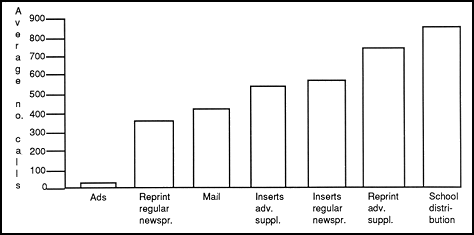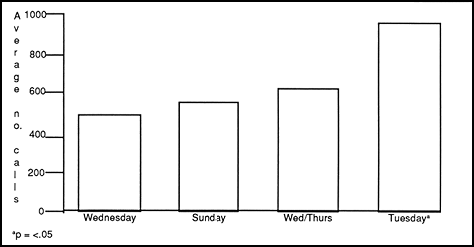Spring 1988 // Volume 26 // Number 1 // Feature Articles // 1FEA4
Instant Health Information
Abstract
Instant Health Info,1 a statewide Extension service, provided toll-free telephone access to over 350 pre-recorded tapes on a wide range of health and safety topics. The program was designed to serve the needs of rural residents, but urban callers weren't excluded. An average of 3,000 calls a month were received in the two years of the program. Because many tapes were about sensitive topics, anonymity was protected, with county of residence the only question asked of callers. Six weeks after the initial burst of free publicity, when calls began to decline, special marketing methods were tried. This article details the effectiveness of those efforts.
Marketing Techniques
Seven different marketing techniques were used from one to 25 times over a period of 18 months in rural Arizona. Four of the techniques related to reprinting and inserting the Instant Health Info program directory in both regular newspapers and "throw-away" advertising supplements. With the fifth and sixth techniques, directories were sent third-class mail and distributed to children at school. Finally, advertisements were placed in subscriber newspapers. The ads were professionally designed, averaged 15-column inches and included a picture of a telephone, copy describing the service, and a number to call for a free directory.
Promotions were tried on all days of the week, but not all promotion types were tried on every day or in every county. Efforts were spaced at least two weeks apart except for newspaper ads, which were repeated several times a week and/or on consecutive weeks. No marketing was scheduled from late November to early January, because similar programs had found the holiday season to be nonproductive.2
The cost of the promotions varied. Reprinting the directory in subscriber newspapers was paid for by sponsors solicited by the newspaper, while reprinting in advertising supplements cost an average of .014 cents per unit delivered. In subscriber and advertising newspapers, insert fees ranged from 2.5 cents to 7 cents with an average cost of 4.5 cents per unit delivered.
Newspaper ads ranged from $26 to $440, with a median of $73. The less costly ads appeared in small papers in remote areas and the more expensive ones in larger circulation papers. Mail delivery cost was 2.6 cents each through a commercial "marriage mail" service where several items are delivered to a residence in one package. Overall, the out-of-pocket costs for all promotions including directory printing ranged from zero to 9.6 cents per individual reached.
To measure the impact of the marketing, a base-use rate was derived for each county by averaging calls for a four-week period each year when no specific publicity was under way. To this number was added a margin for the limits of chance. Calls above the adjusted base were counted as the net response or "new" calls. The cost for each new call ranged from zero to $4.56, with an average of $1.04.
Effectiveness of Techniques
The most effective marketing method was the distribution of directories to elementary school students and the least effective was newspaper ads (see Figure 1). Reprinting the brochure in advertising supplements led, on the average, to a 50% higher return than using the same method in subscriber newspapers.
In control counties of comparable population, where no special promotion was undertaken, usage fluctuated and occasionally exceeded the pre-promotion average. As a rule, counties with the lowest prior use showed the greatest gain from the increased marketing effort.
Except for school distribution, which was implemented only once, there were marked differences in the response levels among and between the different promotions. These distinctions become more meaningful when the average response is divided by the average distribution for each type of promotion. Using this formula, response rates ranged from .15% for ads to 20% for school distribution, with a median of 5% (see Table 1).
The average response was significantly higher when newspaper promotions were done on Tuesdays rather than Wednesdays. Promotions on Sundays or a combination of Wednesdays and Thursdays held intermediate positions (see Figure 2). It's possible that newspaper promotions were less effective on Wednesdays because of competition with grocery specials.
In considering cost-effectiveness and efficiency, advertisements were of least value. No relationship existed between the size of the ad and the number of new calls generated or whether the ad ran only once, once a week for two weeks, or on subsequent days during one or two weeks. Cost per new call ranged from 48 cents to $29.33, with an average of $4.56.
The ultimate in cost-efficiency was when the directory was reprinted in regular newspapers at no cost to the program, but these were one-time only donations. Of the types of marketing where cost was a factor, distribution of printed directories to students in an elementary school was the most cost-effective (see Figure 3). One limitation to this study is that the distribution of directories to students in school was tried only once. Because of extremes in the responses to the various promotions, it's difficult to predict the future.

Figure 1. Net effects of different types of promotion.
Table 1. Promotion results by type and response rate.
Type |
Ads |
Reprint adv. suppl. |
Reprint regular newspr. |
Inserts regular newspr. |
Inserts adv. suppl. |
School distrib. |
|
|---|---|---|---|---|---|---|---|
| Frequency | 25 | 2 | 2 | 3 | 16 | 4 | 1 |
| Average net response |
33 | 723 | 378 | 426 | 575 | 554 | 812a |
| Average response rateb |
.15% | 2.5% | 3% | 4.3% | 6% | 7.5% | 20% |
| aData not averaged-method used only once. bAverage number of new calls divided by average distribution number. |
|||||||

Figure 2. Response by day of week of promotion.

Figure 3. Average cost per new call by type.
Importance of Promotion
Although the size of the tape library and population are important influences, most telephone health information programs succeed in direct proportion to the extent to which they're promoted. Once the initial publicity subsides, periodic promotion is essential to maintain or increase calls.
Experience shows that competing requests from community programs for free mass media publicity usually result in limited exposure for any one program. To supplement what was available without cost, Instant Health Info budgeted funds for marketing activities in rural areas only. Wilkinson and others found that without special marketing, rural residents rarely used Can-Dial, a cancer information service, but with promotion they responded in large numbers.3
Our research confirms the Can-Dial experience: two-thirds of all calls came from rural residents even though they number only one-quarter of the state's population. A previous evaluation of the program4 showed that 80% of users called more than once, so it's assumed that the actual number of callers was considerably lower than the number of calls.
Response levels may be related to the ease by which the information was available. A brochure could be used immediately or set aside for future use, whereas the newspaper listing was more apt to be lost or torn. Having to call and ask for a directory meant giving one's name and address as well as waiting for the brochure. This delay may have been a barrier for all except those most intrigued by the new service. Brochures/directories were also the mainstay of the Boise Tel-Med and Buffalo Can-Dial programs.5 Without these topic guides, prospective callers have little idea about the program or what tapes to ask for.
Implications for Extension
While these data demonstrate the value of marketing a specific health information program, they may have relevance for all Extension programming as we move into bolder marketing. Of particular importance is that the total amount spent on all paid promotion ($8,000 a year) was slightly less than the salary cost of the average time (one hour a week) that each Extension agent spent promoting the program, but the results were strikingly more productive. Finally, getting your message into advertising supplements may be a productive way to reach larger numbers of potential clients.
Footnotes
1. Bernice Epstein, "Instant Health Info: The Telephone Connection" Journal of Extension, XXIII (Summer 1985), 16-18.
2. R. A. Sager, "The Tel-Med Program in Boise, Idaho," in Dial-Access: A Way to Spread Your Message (Madison: University of Wisconsin-Extension, 1979) pp. 227-41 and G. S. Wilkinson, E. A. Mirand, and S. Graham, "Cancer Education by Telephone: A Two Year Evaluation," Health Education Monographs, V (1977), 251-63.
3. G. S. Wilkinson, E. A .S. Mirand, and S. Graham, "Measuring Response to a Cancer Information Telephone Facility: Can-Dial," American Journal of Health Education, LXVI (1976), 370-71.
4. Epstein, "Instant Health Info."
5. Sager, "The Tel-Med Program" and Wilkinson, Mirand, and Graham, "Cancer Education."
